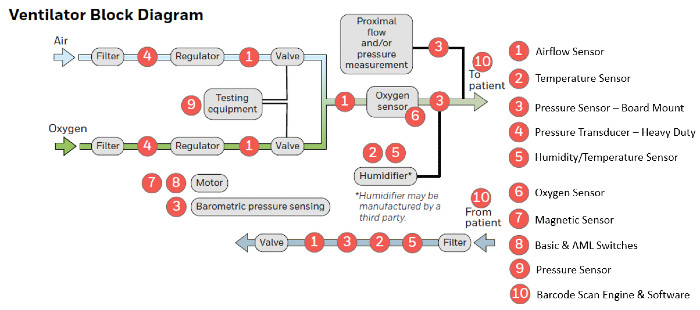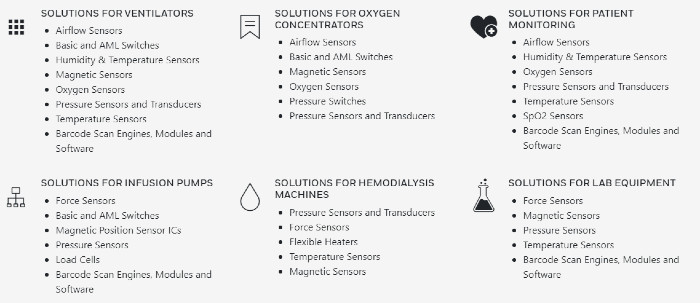For medical applications, product performance is paramount, but the medical landscape is always changing to accommodate new priorities. For example, many traditional clinical functions are transitioning from fixed-based equipment to portable and wearable solutions; there’s a push to empower the consumer with a wide range of diagnostic and fitness products; and an aging worldwide population is giving rise to new fields such as home health and telehealth.
Medical sensor technology must adapt to meet these new market trends. Portables and wearables are forcing an increased emphasis on small size and low weight; the move to battery power demands low-voltage operation and low power consumption; mass-market consumer products are highly cost-sensitive; and home-based health care is adding IoT connectivity to formerly standalone devices. Honeywell’s latest sensor products are more than equal to the challenge.
Honeywell’s medical sensor portfolio: a legacy of excellence
Sensors play a critical role in medical equipment. The medical ventilator shown in Figure 1, for example, requires sensors to measure pressure, gas flow, humidity, and temperature; scan barcodes; and monitor motor performance. Other medical devices use many of these same sensors, plus others.

COPYRIGHT © 2020 HONEYWELL INTERNATIONAL INC.
Figure 1: A medical application such as a ventilator requires sensors to measure a wide variety of parameters. (Image: Honeywell)
Honeywell makes a sensor for each one of these functions. Building on a 75-year legacy of performance, the company offers a comprehensive portfolio of sensor solutions for medical applications. The portfolio includes:
• Airflow sensors
• Humidity and temperature sensors
• Magnetic sensors
• Force sensors
• Oxygen sensors
• Pressure sensors and transducers
• Temperature sensors
• SPO2 sensors
Honeywell medical sensors are ideally suited for a broad range of medical applications. Figure 2 maps the product applicability.

COPYRIGHT © 2020 HONEYWELL INTERNATIONAL INC.
Figure 2: A selection of medical applications served by Honeywell’s sensors and switches (Image: Honeywell)
Honeywell’s latest products target portable and wearable applications
Accurate measurement of pressure, force, and flow is a critical requirement in numerous medical applications. Honeywell’s recent product introductions in these areas are aimed squarely at the large and growing portable and wearable segments, combining high performance, small size, low power consumption, and a choice of digital interfaces.
Here are a few examples of these new sensors, shown in Figure 3.

Figure 3: Honeywell’s new sensors are optimized for portable and wearable medical applications. (Image: Honeywell)
MPR pressure sensors for consumer medical applications
Consumer medical applications are extremely cost-sensitive, yet still demand high performance. MPR pressure sensors are designed to meet the requirements of higher-volume medical devices in both consumer and non-consumer applications. Consumer applications include non-invasive blood pressure monitoring, negative-pressure wound therapy, breast pumps, mobile oxygen concentrators, airflow monitors, CPAP water tanks, and medical wearables.Non-consumer applications include invasive blood pressure monitors and ambulatory blood pressure measurement systems.
MPR sensors use an internal application-specific integrated circuit (ASIC) to calibrate and compensate the output for sensor offset, sensitivity, temperature effects, and non-linearity over a range of 0°C to 50°C (32°F to 122°F). This feature saves manufacturing cost by minimizing test and calibration time during production.
The sensors are ideally suited to battery-powered portable and wearable applications, as they feature small size and weight combined with low power consumption. MPR devices feature a tiny package footprint of 5 × 5 mm (0.20 × 0.20 in.). They operate from a 3.3-V supply and consume less than 2.25mW typical for sample rates of 1 to 160 samples per second (sps); idle power consumption is only 5.4 nW.
MPR sensors offer designers a choice of IoT-ready I2C and SPI interfaces. Customers can specify either long or short packages, depending on packaging requirements.
ABP2 pressure sensors are designed for clinical applications
For clinical applications, the ABP2 series of piezoresistive pressure sensors in Figure 3(b) combine high accuracy with small size, making them ideal for printed-circuit-board mounting in space-constrained applications such as portable ventilators, CPAP machines, blood pressure monitors, and drug-dosing systems.
The ABP2 family offers enhanced features for clinical applications, including accuracy of ±0.25% FSS BFSL and long-term stability of ±0.25% FSS.
An onboard ASIC provides calibration and temperature compensation for a variety of errors: sensor offset, sensitivity, temperature effects, and accuracy errors such as non-linearity, repeatability, and hysteresis. The output values are corrected for pressure and temperature effects approximately every 5 ms (200-Hz rate). The devices are calibrated over a wide operating temperature range of –40°C to 110°C (–40°F to 230°F). The total error band (TEB) is as low as ±1.5% FSS.
The ABP2 series also offers a liquid media option; this is a protective silicone-based gel coating that enables the device to be used with non-corrosive liquids, such as water and saline, or in applications where condensation can occur. A temperature output is available.
FMA MicroForce sensors
The FMA series of MicroForce sensors, shown in Figure 3(c), are piezoresistive-based force sensors that offer a ratiometric digital output over the specified full-scale force span and temperature range. Medical applications of these sensors include infusion pumps, ambulatory pumps, enteral feeding pumps, and kidney dialysis machines.
The sensor output is directly proportional to the force applied to the mechanically coupled stainless-steel sphere on the top surface of the package. The direct mechanical coupling allows for easy interface with the sensor via tubing, membrane, or a plunger, providing repeatable performance and a reliable interface. In addition, the FMA features diagnostic functions that verify proper operation by detecting open- or short-circuited paths inside the sensor.
Like other recent product introductions, the FMA series is designed for space-constrained, battery-powered applications: it comes in a tiny 5 × 5-mm (0.20 × 0.20-in.) package, offers the choice of convenient I2C or SPI digital interfaces, and can operate from a 3.3-V or a 5-V supply.
Enhanced accuracy of ±2% FSS BFSL typical is provided over a force range of 0N to 25N and a temperature range of 5°C to 50°C (41°F to 122°F); over this range, the device compensates for errors due to force non-linearity, force hysteresis, and non-repeatability. The TEB of ±8% FSS enhances system performance.
Other Honeywell sensors for medical applications
These new sensor families complement a portfolio that includes existing sensor families such as:
Airflow Sensors: Honeywell Zephyr HAF Series, AWM series
Barcode Scan Engines & Software: N670X/N660X Series; SwiftDecoder
Basic and AML Switches: DM, Z, and V15W Basics; AML Series (PB & Rockers)
Force Sensors: FSA Series, FSG Series, FSS Series, TBF Series, 1865 Series
Humidity/Temperature Sensors: HIH-4000/6000/6100 SeriesHIH-7000/8000 Series
Magnetoresistive Position Sensors: ICsSM Series
Magnetic Sensors: SS360/SS460 Series
Oxygen Sensors: OOM Series
Pressure Sensors — Board Mount: TruStability HSC Series, Basic ABP Series
Pressure Transducers — Heavy Duty: MIP Series, MLH Series
Pressure Sensors: FP5000 Series
Temperature Sensors: 192 Series, 194 Series, 500 Series
These sensors cover a broad range of medical applications, including respiratory care, fluid delivery management, diagnostic and analytical equipment, patient monitoring and acute testing, surgical equipment, support products, hospital or clinic hardware, and rehabilitation.
Medical sensor resources: find out more
Honeywell offers a comprehensive set of resources on sensors for medical applications. In addition to individual product datasheets, resources include webinars, application demos, overview brochures, and more. The complete list of Honeywell medical sensors is located here.
Information on the Honeywell’s new sensor products can also be found on Arrow’s Honeywell Sensor NPI landing page.

